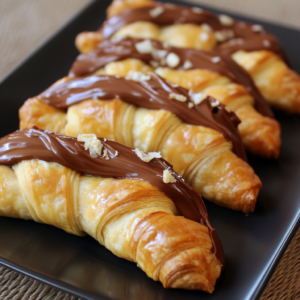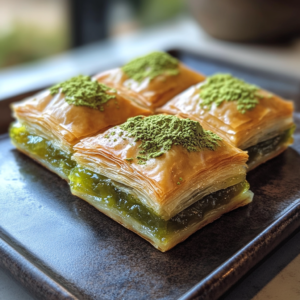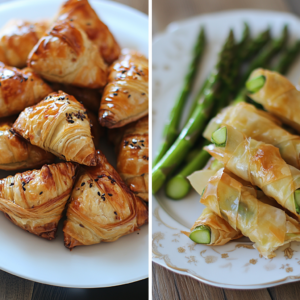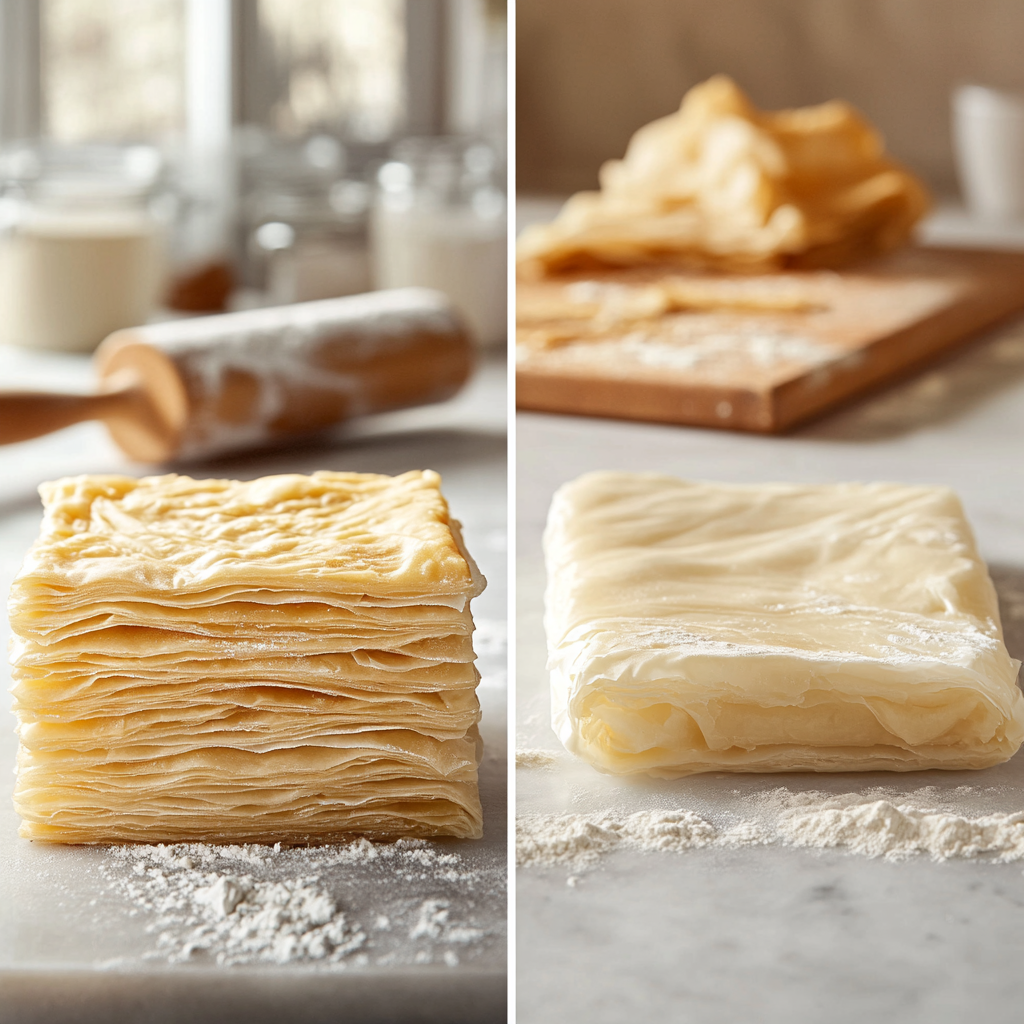Puff pastry and phyllo dough are two popular ingredients in the world of baking, both known for their flaky, crispy textures. However, they are not the same. While they may look similar and are often used to create layered, crispy dishes, puff pastry and phyllo dough have distinct differences in their ingredients, preparation, and culinary uses. In this article, we will explore the key differences and similarities between these two types of dough, ultimately helping you decide which one to use in your recipes.
Understanding Puff Pastry
Puff pastry, also known as pâte feuilletée, is a rich, buttery pastry that’s famous for its light, airy layers. It is used in both sweet and savory dishes, ranging from turnovers and tarts to savory pies and beef Wellington.
Ingredients and Preparation
Puff pastry is made from a simple yet rich combination of flour, water, salt, and a high amount of butter (or sometimes margarine). As the dough is prepared, it is folded and rolled multiple times, creating alternating layers of dough and butter. Eventually, when baked, the butter melts, creating steam that causes the dough to puff up, therefore resulting in a flaky, airy texture.
The preparation of puff pastry is labor-intensive, often requiring the following steps:
- Butter Block Creation: A block of chilled butter is placed in the center of the dough.
- Folding and Rolling: The dough is folded and rolled out repeatedly to create layers.
- Chilling: The dough must be chilled between folds to keep the butter from melting.
Deep Dive into Puff Pastry Preparation
Understanding Puff Pastry Layers
The secret behind the iconic puff pastry texture lies in its laminated layers. To achieve this, traditional puff pastry requires folding the dough around a butter block, which gradually creates hundreds of thin layers. As a result, when baked, these layers expand to produce a light, flaky texture. Let’s delve deeper into the layering process:
- The Dough Fold Technique: First, the dough is folded over the butter and then rolled out several times in a process called “turns.” After each turn, the dough is chilled to maintain the butter’s integrity. Typically, there are 6-7 turns in total.
- Chilling Is Crucial: To achieve maximum puffiness, it’s crucial to chill the dough thoroughly between turns. This step ensures that the cold butter creates steam during baking, helping the dough rise effectively.
- Alternative Versions: While traditional puff pastry involves hours of folding, there are quicker alternatives. For example, you can opt for rough puff pastry, which is faster but still delivers satisfying flakiness. In this method, chunks of butter are incorporated into the dough, followed by rolling and folding.
Recipe Idea: Cheese and Herb Puff Pastry Twists
Ingredients:
- 1 sheet of puff pastry (store-bought or homemade)
- 1 cup grated Parmesan cheese
- 2 tablespoons chopped fresh herbs (thyme, rosemary, or parsley)
- 1 egg (for egg wash)
Instructions:
- Preheat your oven to 400°F (200°C).
- Roll out the puff pastry and sprinkle cheese and herbs evenly over the surface.
- Fold the dough in half, press gently, and slice into 1-inch strips.
- Twist each strip and arrange them on a baking sheet lined with parchment paper.
- Lightly brush with egg wash and bake for 12–15 minutes until golden brown.
If you’re looking for more ideas, check out Ground Venison Recipes, which offer a variety of ways to enjoy this lean and flavorful protein.
Uses of Puff Pastry

Puff pastry is versatile and works well in both sweet and savory recipes. It is often used in:
- Pastries and Danish: Sweet treats filled with fruit, cream cheese, or chocolate.
- Pies and Tarts: Used as a base for savory pies, quiches, or fruit tarts.
- Savory Appetizers: Wrapped around fillings like cheese, sausage, or vegetables.
- Vol-au-Vents and Beef Wellington: Classic dishes that rely on puff pastry’s signature puffiness.
Regional Dishes Featuring Puff Pastry
- France: As the home of buttery croissants, France uses puff pastry for a range of desserts, such as mille-feuille and tarte tatin.
- Denmark: Danish pastries, often filled with custard, fruit, or almond paste, greatly rely on puff pastry’s airy layers.
- Spain: In Spain, empanadas de hojaldre (puff pastry turnovers) are popular, filled with ingredients like tuna, vegetables, or minced meat.
What is Phyllo Dough?
Phyllo dough, also spelled “filo,” is a paper-thin pastry commonly used in Mediterranean, Middle Eastern, and Balkan cuisines. It is known for its crisp, flaky texture and is often used to create multi-layered dishes.
Ingredients and Preparation
Phyllo dough is made from flour, water, vinegar, and a small amount of oil. Unlike puff pastry, phyllo dough contains no butter or fat within its layers. Instead, it relies on brushing each sheet with butter or oil during assembly to achieve its crispy, golden layers when baked.
Preparing phyllo dough involves:
- Rolling the Dough: Phyllo dough is rolled extremely thin, almost transparent.
- Layering: It is typically used by stacking multiple sheets together, brushing each layer with melted butter or oil.
- Baking: The sheets crisp up in the oven, creating a delicate, shatteringly crisp texture.
Phyllo Dough Layering Techniques
Achieving the Perfect Crispness with Phyllo Dough
Working with phyllo dough requires some finesse, but these additional tips can help you master it:
- Using Butter vs. Oil: While melted butter is the traditional choice, olive oil or ghee can be used to brush between phyllo layers, creating a crispier, lighter texture. Use a pastry brush for even application.
- Layering for Savory Dishes: When making dishes like spanakopita, use at least 8-10 sheets for the bottom and top layers. For extra crunch, brush each layer generously with butter.
- Baking Tip: Phyllo dough bakes best at 350°F (175°C) to prevent burning while ensuring even crisping.
Recipe Idea: Phyllo-Wrapped Asparagus Spears
Ingredients:
- 1 package of phyllo dough (thawed)
- 1 bunch of asparagus (trimmed)
- Olive oil for brushing
- Grated Parmesan cheese
- Salt and pepper
Instructions:
- Preheat your oven to 375°F (190°C).
- Cut the phyllo sheets into 4-inch-wide strips.
- Wrap each asparagus spear in a strip of phyllo, brushing with olive oil and sprinkling with Parmesan.
- Arrange on a baking sheet and bake for 12–15 minutes until golden brown.
Uses of Phyllo Dough
Phyllo dough adds a distinct, crunchy texture to many dishes. You will often find it in:

- Baklava: A classic sweet dish made with layers of phyllo, nuts, and honey syrup.
- Spanakopita: A savory Greek spinach pie with feta cheese.
- Börek: A popular savory pie found in Turkish and Balkan cuisines, often filled with meat, cheese, or vegetables.
- Phyllo Cups: Used as edible shells for both sweet and savory fillings.
Regional Dishes Featuring Phyllo Dough
- Greece: Baklava, a popular dessert made with layers of phyllo, chopped nuts, and honey, originates from Greece.
- Turkey: you will often find Börek, a classic dish made with phyllo dough, filled with cheese, minced meat, or spinach.
- Middle East: Phyllo-based desserts like kunafa and baklava are staples in Middle Eastern cuisine, often filled with nuts or sweetened cheese.
Key Differences Between Puff Pastry and Phyllo Dough
Although both puff pastry and phyllo dough can create flaky, layered dishes, their differences are significant. Here are the main differences:
1. Texture
- Puff Pastry: It’s thicker, airier, and creates a puffed, flaky texture when baked.
- Phyllo Dough: It’s thinner and crispier, resulting in a delicate crunch.
2. Ingredients
- Puff Pastry: Contains butter within its layers, contributing to its rich taste and puffiness.
- Phyllo Dough: Does not contain butter within the dough; it relies on external butter or oil for crispness.
3. Preparation
- Puff Pastry: Involves folding and rolling to create multiple layers, making it labor-intensive.
- Phyllo Dough: Bakers roll it thin and stack it, making it easier to handle, although it remains more fragile.
4. Calories and Fat
- Puff Pastry: Has a higher fat and calorie content due to the butter layers.
- Phyllo Dough: Is lower in fat and calories, making it a lighter option.
Healthier Options for Both Pastries
- Puff Pastry: Although puff pastry is rich in butter, you can make it slightly healthier by using whole wheat flour or opting for low-fat butter substitutes. However, keep in mind that this adjustment may affect its puffiness.
- Phyllo Dough: On the other hand, phyllo dough is a naturally low-fat option. You can make it even healthier by reducing the butter or oil brushed between layers. Additionally, you can spray olive oil lightly for a lower-fat application.
Nutritional Breakdown (Per 100g)
- Puff Pastry: 558 calories, 45g fat, 36g carbs, 7g protein.
- Phyllo Dough: 288 calories, 5g fat, 55g carbs, 8g protein.
5. Culinary Uses
- Puff Pastry: Best for dishes that require a substantial, buttery crust.
- Phyllo Dough: Ideal for creating crisp, light layers in both sweet and savory dishes.
For more ideas on using phyllo dough creatively, visit Phyllo Dough Recipes, where you’ll find crispy and delicious dishes for any occasion.
Cooking Tips for Puff Pastry and Phyllo Dough
Puff Pastry Tips
- Keep It Cold: Always keep the puff pastry cold while working with it. If the butter melts before baking, you won’t achieve the signature puffiness.
- Use Sharp Tools: Use a sharp knife or pastry cutter when working with puff pastry to maintain clean edges.
- Brush with Egg Wash: For a shiny, golden finish, brush the puff pastry with an egg wash before baking.
Phyllo Dough Tips
- Work Quickly: Phyllo dough dries out rapidly, so work quickly and keep the sheets covered with a damp cloth to prevent them from becoming brittle.
- Brush Each Layer: To ensure a crispy texture, brush each phyllo layer with melted butter or oil during assembly.
- Avoid Overfilling: Phyllo dough is thin and fragile, so avoid overfilling to prevent tearing or sogginess.
Can You Substitute One for the Other?
While puff pastry and phyllo dough both create flaky dishes, they are not always interchangeable due to differences in texture and fat content. However, there are a few instances where you can substitute them with some adjustments:
- For pies and tarts: You can easily use phyllo dough as a lighter alternative to puff pastry by stacking several layers to create a sturdy crust. However, be aware that the texture will be crispier than that of puff pastry.
- For savory dishes: Puff pastry can certainly replace phyllo in some savory recipes. However, you should expect a richer and puffier result due to its higher butter content.
- For desserts: Use phyllo dough instead of puff pastry in certain desserts. This substitution creates a crispier and lighter final result, offering a more delicate bite. For more tips on classic dessert recipes, explore this article on Philadelphia Cheesecake Recipe.
Substitution Tips
How to Substitute Puff Pastry for Phyllo Dough
- Use in Savory Pies: When using puff pastry in place of phyllo dough for savory pies, bake at a slightly higher temperature (around 400°F) to ensure a crispy crust.
- Adjust the Layers: If using phyllo instead of puff pastry, stack at least 8 layers to create a sturdier base.
Recipe Idea: Puff Pastry Baklava
While traditional baklava uses phyllo, you can create a unique twist using puff pastry. Here’s how:
Ingredients:
- 1 sheet of puff pastry
- 1 cup chopped walnuts
- ½ cup honey
- 1 teaspoon cinnamon
Instructions:
- Preheat your oven to 350°F (175°C).
- Roll out the puff pastry and layer it with chopped nuts and cinnamon.
- Fold the pastry in half, press gently, and bake for 15-20 minutes.
- Drizzle with warm honey and serve.
Which One Should You Use?
The choice between puff pastry and phyllo dough ultimately depends on the dish you are making:
- Choose Puff Pastry If:
- You are specifically looking for a rich, buttery flavor, as it adds a decadent touch to your recipe.
- Additionally, you’re planning to make pies, turnovers, or similar dishes that require a more substantial, flaky crust.
- Choose Phyllo Dough If:
- You prefer a lighter, crispier texture, which complements dishes without making them too heavy.
- Moreover, you’re preparing Mediterranean or Middle Eastern dishes like baklava or spanakopita, where phyllo’s delicate layers work best.
Creative Uses for Both Pastries

Creative Recipes with Puff Pastry and Phyllo Dough
Sweet Puff Pastry Ideas
- Nutella Puff Pastry Twists: Spread Nutella over a sheet of puff pastry, cut into strips, and twist before baking.
- Apple Cinnamon Puffs: Fill puff pastry squares with cinnamon-sugar apples, fold into triangles, and bake until golden brown.
Savory Phyllo Dough Ideas
If you’re looking for creative ways to use phyllo dough in savory recipes, consider these delicious options:
- Phyllo Pizza Rolls: For a quick and tasty snack, roll up phyllo sheets with tomato sauce, cheese, and pepperoni. Then, bake until golden brown to enjoy a crispy phyllo-based twist on classic pizza.
- Cheese and Herb Phyllo Cups: To create a flavorful appetizer, form mini phyllo cups in a muffin tin. Next, fill them with a mixture of feta, spinach, and herbs. Bake until crisp, and you’ll have a savory treat that’s perfect for any occasion.
Final Thoughts
While puff pastry and phyllo dough share similarities in appearance and flaky textures, they differ greatly in ingredients, preparation, and culinary applications. Puff pastry offers a rich, buttery flavor with a thick, airy texture, making it perfect for hearty dishes. On the other hand, phyllo dough provides a lighter, crisper texture that’s ideal for Mediterranean and Middle Eastern cuisine.
Now that you understand the differences between puff pastry and phyllo dough, you can confidently choose the right pastry for your recipe. Both are versatile and delicious in their own way, enhancing a wide variety of sweet and savory dishes.
